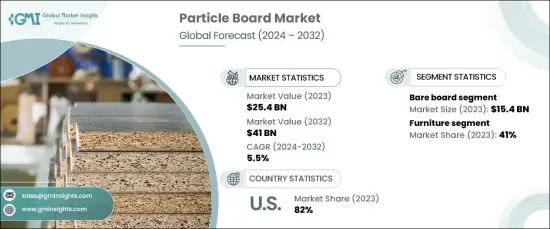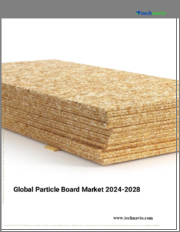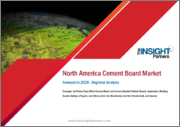
|
시장보고서
상품코드
1664861
파티클 보드 시장 기회, 성장 촉진요인, 산업 동향 분석 및 예측(2024-2032년)Particle Board Market Opportunity, Growth Drivers, Industry Trend Analysis, and Forecast 2024 - 2032 |
||||||
세계의 파티클 보드 시장은 2023년에 254억 달러로 평가되었고, 2024년부터 2032년에 걸쳐 5.5%의 연평균 복합 성장률(CAGR)로 견조하게 성장할 것으로 예측되고 있습니다.
이 성장의 원동력이 되고 있는 것은 경제적, 사회적, 기술적 진보에 의한 다양한 분야에서 수요 증가입니다.

시장 확대의 주요 촉진요인 중 하나는 특히 발전 지역에서 급성장하는 가구 산업입니다. 도시화와 중산 계급 증가로, 저렴한 가격으로 기능적인 가구에 대한 수요가 탄생하고 있습니다. 비용 효율성과 다양성으로 알려진 파티클 보드는 조립식(RTA) 가구, 캐비닛 및 저장 솔루션을 제조하는 데 널리 사용됩니다. 합리적인 가격과 적응성으로 인해 소비자와 제조업체 모두에게 선호되는 옵션이 되었습니다.
| 시장 범위 | |
|---|---|
| 시작 연도 | 2023년 |
| 예측 연도 | 2024-2032년 |
| 시작 금액 | 254억 달러 |
| 예측 금액 | 410억 달러 |
| CAGR | 5.5% |
시장은 베어 보드와 라미네이트 보드의 두 가지 주요 부문으로 나뉩니다. 베어보드 부문은 2023년에 154억 달러를 창출했고 2032년까지 연평균 복합 성장률(CAGR) 5.7%로 성장할 것으로 예측됩니다. 베어 보드는 제조 비용이 낮기 때문에 예산에 맞는 솔루션을 중시하는 산업과 소비자에게 매력적인 선택입니다. 이 보드는 실용성과 비용 효율성이 높기 때문에 저렴한 주택 프로젝트, 건설 및 가구 생산에 일반적으로 사용됩니다.
응용 분야에서 파티클 보드 시장은 가구, 캐비닛, 바닥재, 문, 천장 패널, 벽재, 포장 등 다양한 산업에 걸쳐 있습니다. 가구 분야는 2023년에 41%의 압도적 점유율을 차지했으며, 2024년부터 2032년까지 5.7%의 성장률을 유지할 것으로 예측됩니다. 합리적인 가격으로 대량 생산에 적합하기 때문에 파티클 보드는 도시 지역의 세련되고 저렴한 가구에 대한 수요 증가에 부응하는 가구 제조업체에게 의지가되는 재료입니다.
미국에서 파티클 보드 시장은 2023년 82%의 큰 점유율을 차지했습니다. 대도시의 도시화와 주택 수요 증가로 인해 비용 효율적인 건축자재의 요구가 커지고 있습니다. 주택 가격이 계속 상승하는 동안, 파티클 보드는 단단한 재료와 합판과 같은 값 비싼 재료를 대체하는 실용적인 대체품이되어 바닥 바닥, 벽 및 기타 구조 요소에 적용됩니다.
목차
제1장 조사 방법과 조사 범위
- 시장 범위와 정의
- 기본 추정과 계산
- 예측 계산
- 데이터 소스
- 1차
- 2차
- 유료 소스
- 공개 소스
제2장 주요 요약
제3장 업계 인사이트
- 업계 생태계 분석
- 밸류체인에 영향을 주는 요인
- 이익률 분석
- 방해
- 향후 전망
- 제조업체
- 유통업체
- 공급자의 상황
- 이익률 분석
- 주요 뉴스·이니셔티브
- 규제 상황
- 영향요인
- 성장 촉진요인
- 건설 활동 증가
- 가구시장의 성장
- 업계의 잠재적 리스크·과제
- 시장의 포화와 경쟁의 격화
- 지속가능성에 대한 우려
- 성장 촉진요인
- 성장 가능성 분석
- Porter's Five Forces 분석
- PESTEL 분석
제4장 경쟁 구도
- 서론
- 기업의 시장 점유율 분석
- 경쟁 포지셔닝 매트릭스
- 전략 전망 매트릭스
제5장 시장 추계·예측 : 제품 유형별(2021-2032년), 10억 달러
- 주요 동향
- 베어 보드
- 단층 파티클 보드
- 3층 파티클 보드
- 등급 밀도 파티클 보드
- 시멘트 결합 파티클 보드
- 기타
- 적층 파티클 보드
- 베니어드 파티클 보드
- 멜라민 파티클 보드
- 기타
제6장 시장 추계·예측 : 용도별(2021-2032년), 10억 달러
- 주요 동향
- 가구
- 바닥재
- 캐비닛
- 문
- 벽 클래딩
- 천장 패널
- 포장
- 기타(조리대, 셔터 등)
제7장 시장 추계·예측 : 최종 용도별(2021-2032년), 10억 달러
- 주요 동향
- 주택용
- 상업용
- 산업용
제8장 시장 추계·예측 : 유통 채널별(2021-2032년), 10억 달러
- 주요 동향
- 직접
- 간접
제9장 시장 추계·예측 : 지역별(2021-2032년), 10억 달러
- 주요 동향
- 북미
- 미국
- 캐나다
- 유럽
- 영국
- 독일
- 프랑스
- 이탈리아
- 스페인
- 러시아
- 아시아태평양
- 중국
- 인도
- 일본
- 한국
- 호주
- 라틴아메리카
- 브라질
- 멕시코
- 중동 및 아프리카
- UAE
- 사우디아라비아
- 남아프리카
제10장 기업 프로파일
- Arauco
- Daewon Industrial
- Duratex
- Egger Group
- Finsa
- Georgia-Pacific
- Homanit
- Kastamonu Entegre
- Kronospan
- Masonite
- Nelson Pine
- Pfleiderer
- Sumitomo Forestry
- Swedish Wood
- Uniboard
The Global Particle Board Market, valued at USD 25.4 billion in 2023, is projected to grow at a robust CAGR of 5.5% from 2024 to 2032. This growth is fueled by increasing demand across various sectors, driven by economic, societal, and technological advancements.

One of the primary drivers of this market expansion is the rapidly growing furniture industry, particularly in developing regions. Urbanization and the rising middle class are creating a demand for affordable, functional furniture. Particle board, known for its cost-efficiency and versatility, is widely used in manufacturing ready-to-assemble (RTA) furniture, cabinets, and storage solutions. Its affordability and adaptability make it the preferred choice for both consumers and manufacturers alike.
| Market Scope | |
|---|---|
| Start Year | 2023 |
| Forecast Year | 2024-2032 |
| Start Value | $25.4 billion |
| Forecast Value | $41 billion |
| CAGR | 5.5% |
The market is divided into two major segments: bare and laminated boards. The bare board segment generated USD 15.4 billion in 2023 and is expected to grow at a CAGR of 5.7% through 2032. The low production cost of bare boards makes them an attractive option for industries and consumers focused on budget-friendly solutions. These boards are commonly used in affordable housing projects, construction, and furniture production due to their practicality and cost-effectiveness.
When it comes to applications, the particle board market spans various industries, including furniture, cabinets, flooring, doors, ceiling panels, wall cladding, and packaging. The furniture sector held a dominant 41% share in 2023 and is projected to maintain a growth rate of 5.7% from 2024 to 2032. The combination of affordability and suitability for mass production makes particle boards a go-to material for furniture manufacturers seeking to meet the rising demand for stylish yet affordable furniture in urban areas.
In the U.S., the particle board market accounted for a significant 82% share in 2023. Urbanization and growing housing demands in major cities have led to an increase in the need for cost-effective construction materials. As home prices continue to rise, particle board has become a practical alternative to more expensive materials like solid wood and plywood, with applications in subflooring, walls, and other structural elements.
Table of Contents
Chapter 1 Methodology & Scope
- 1.1 Market scope & definitions
- 1.2 Base estimates & calculations
- 1.3 Forecast calculations.
- 1.4 Data sources
- 1.4.1 Primary
- 1.4.2 Secondary
- 1.4.2.1 Paid sources
- 1.4.2.2 Public sources
Chapter 2 Executive Summary
- 2.1 Industry synopsis, 2021-2032
Chapter 3 Industry Insights
- 3.1 Industry ecosystem analysis
- 3.1.1 Factor affecting the value chain.
- 3.1.2 Profit margin analysis.
- 3.1.3 Disruptions
- 3.1.4 Future outlook
- 3.1.5 Manufacturers
- 3.1.6 Distributors
- 3.2 Supplier landscape
- 3.3 Profit margin analysis.
- 3.4 Key news & initiatives
- 3.5 Regulatory landscape
- 3.6 Impact forces
- 3.6.1 Growth drivers
- 3.6.1.1 Increasing construction activities
- 3.6.1.2 Growing furniture market
- 3.6.2 Industry pitfalls & challenges
- 3.6.2.1 Market saturation and intense competition
- 3.6.2.2 Sustainability concerns
- 3.6.1 Growth drivers
- 3.7 Growth potential analysis
- 3.8 Porter’s analysis
- 3.9 PESTEL analysis
Chapter 4 Competitive Landscape, 2023
- 4.1 Introduction
- 4.2 Company market share analysis
- 4.3 Competitive positioning matrix
- 4.4 Strategic outlook matrix
Chapter 5 Market Estimates & Forecast, By Product Type, 2021-2032 (USD Billion) (Thousand Square Feet)
- 5.1 Key trends
- 5.2 Bare board
- 5.2.1 Single-layer particle board
- 5.2.2 Three-layer particle board
- 5.2.3 Graded-density particle board
- 5.2.4 Cement-bonded particle board
- 5.2.5 Others
- 5.3 Laminated particle board
- 5.3.1 Veneered particle board
- 5.3.2 Melamine particle board
- 5.3.3 Others
Chapter 6 Market Estimates & Forecast, By Application, 2021-2032 (USD Billion) (Thousand Square Feet)
- 6.1 Key trends
- 6.2 Furniture
- 6.3 Flooring
- 6.4 Cabinets
- 6.5 Doors
- 6.6 Wall cladding
- 6.7 Ceiling panels
- 6.8 Packaging
- 6.9 Others (countertop, shutter, etc.)
Chapter 7 Market Estimates & Forecast, By End-use, 2021-2032 (USD Billion) (Thousand Square Feet)
- 7.1 Key trends
- 7.2 Residential
- 7.3 Commercial
- 7.4 Industrial
Chapter 8 Market Estimates & Forecast, By Distribution Channel, 2021-2032 (USD Billion) (Thousand Square Feet)
- 8.1 Key trends
- 8.2 Direct
- 8.3 Indirect
Chapter 9 Market Estimates & Forecast, By Region, 2021-2032 (USD Billion) (Thousand Square Feet)
- 9.1 Key trends
- 9.2 North America
- 9.2.1 U.S.
- 9.2.2 Canada
- 9.3 Europe
- 9.3.1 UK
- 9.3.2 Germany
- 9.3.3 France
- 9.3.4 Italy
- 9.3.5 Spain
- 9.3.6 Russia
- 9.4 Asia Pacific
- 9.4.1 China
- 9.4.2 India
- 9.4.3 Japan
- 9.4.4 South Korea
- 9.4.5 Australia
- 9.5 Latin America
- 9.5.1 Brazil
- 9.5.2 Mexico
- 9.6 MEA
- 9.6.1 UAE
- 9.6.2 Saudi Arabia
- 9.6.3 South Africa
Chapter 10 Company Profiles
- 10.1 Arauco
- 10.2 Daewon Industrial
- 10.3 Duratex
- 10.4 Egger Group
- 10.5 Finsa
- 10.6 Georgia-Pacific
- 10.7 Homanit
- 10.8 Kastamonu Entegre
- 10.9 Kronospan
- 10.10 Masonite
- 10.11 Nelson Pine
- 10.12 Pfleiderer
- 10.13 Sumitomo Forestry
- 10.14 Swedish Wood
- 10.15 Uniboard

















